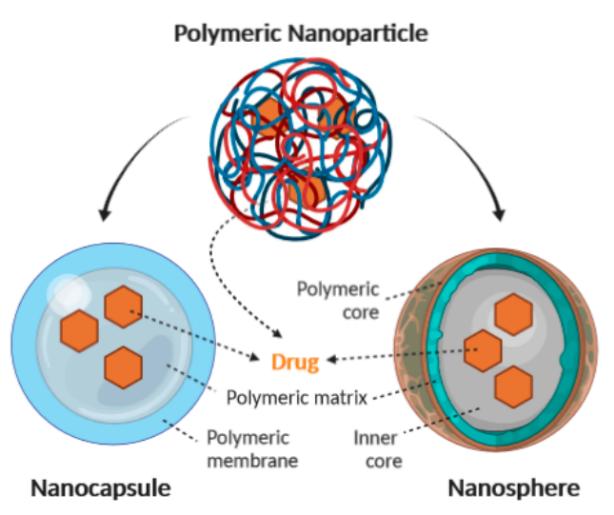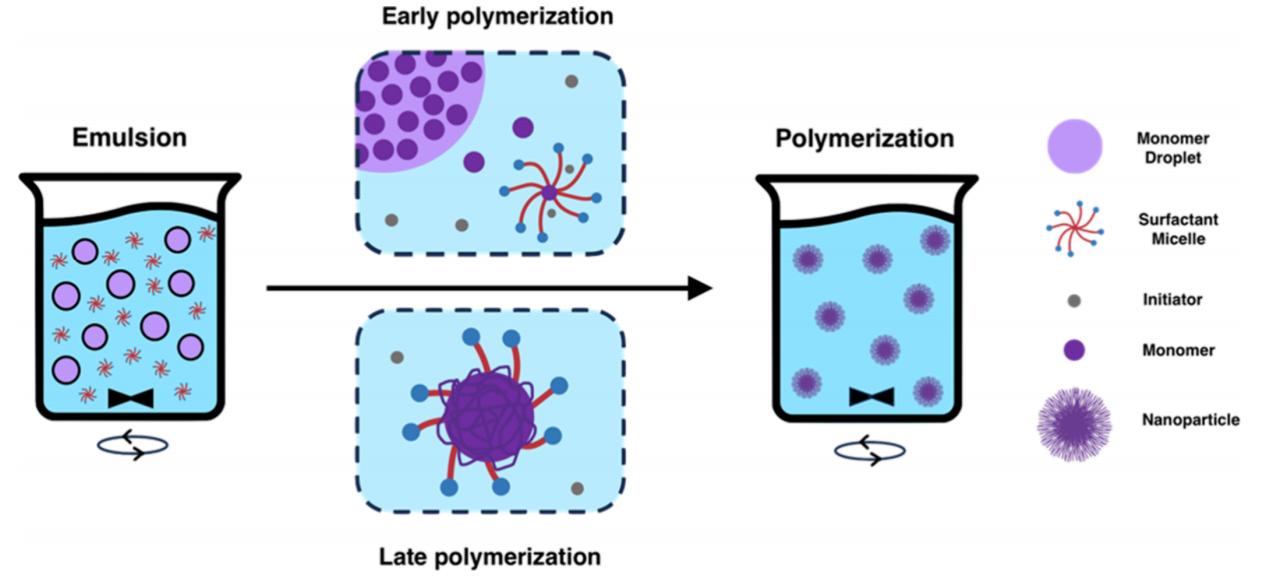Polymeric Nanoparticle Development for Nanomedicine
Inquiry
Polymeric nanoparticles are colloidal carrier systems formed from biodegradable macromolecular polymers through emulsification. Polymeric nanoparticles apply polymeric materials to drug delivery in the biomedical field, which can achieve controlled release and targeted drug delivery of poorly soluble drugs in the body and reduce the toxic and side effects of drugs. CD Formulation utilizes cutting-edge technology for creating polymeric nanoparticles to offer formulation development services for our clients, including nanocapsule and nanosphere formulations.
Classification and Advantages of Polymeric Nanoparticles
Polymeric nanoparticles (PNPs) are particles ranging from 1 to 1000 nm that can carry active compounds trapped within or surface-adsorbed on the polymer core. These two types of polymeric nanoparticles including reservoir system (nanocapsule), and matrix system (nanosphere).
 Fig.1 Schematic representation of the structure of nanocapsules and nanospheres. (Aleksandra Zielinska, et al. 2020)
Fig.1 Schematic representation of the structure of nanocapsules and nanospheres. (Aleksandra Zielinska, et al. 2020)
The advantages of polymeric nanoparticles as carriers include the following:
- Provides controlled release from the matrix structure to target areas of the body.
- Encapsulates unstable molecules (such as DNA, RNA and proteins) and prevents degradation.
- Choose to modify the surface with ligands.
- Protect drug molecules and their specific targeting.
- Have good stability in vivo and in vitro.
Our Workflow of Polymeric Nanoparticle Fabrication
To enter the market, polymeric nanoparticles need to go through the following steps: market demand, research and development, manufacturing technology, scaling-up feasibility, clinical trials and regulatory issues. CD Formulation specializes in the research and development of polymeric nanoparticles. We offer professional services in development, quality control research, and manufacturing of polymeric nanoparticles to our clients. And we will produce PNPs that meet your requirements through the following three steps.
 Fig.2 Our workflow for polymeric nanoparticle fabrications. (CD Formulation)
Fig.2 Our workflow for polymeric nanoparticle fabrications. (CD Formulation)
Explore Our Polymeric Nanoparticle Preparation Methods
The choice of a specific method usually depends on the type of polymer, the physicochemical properties of the drug and the final desired properties of the PNPs. We have developed many different methods to prepare lipid nanoparticles (LNPs) through years of research experience, including based on monomer polymerization (such as microemulsion, emulsion, miniemulsion, controlled/living radical and interfacial polymerization technology) and based on dispersion of prefabricated polymers (such as emulsification-solvent diffusion, emulsification-solvent evaporation, nanoprecipitation, dialysis, salting out and supercritical fluid technology).
| Types of Polymers |
Preparation Methods |
| Polymerization of Monomers |
- Emulsion
- Miniemulsion
- Microemulsion
- Interfacial Polymerization
- Controlled/Living Radical
|
| Prefabricated Polymers |
- Emulsification- Solvent Evaporation
- Emulsification- Solvent Diffusion
- Salting Out
- Nanoprecipitation
- Dialysis
- Supercritical Fluid Technology
|
Besides the methods mentioned earlier, we also offer the option to customize polymeric nanoparticles containing various drugs, such as gold-based polymeric nanoparticles (AuNPs), gadolinium polymeric nanoparticles (GdNPs), perfluorocarbons polymeric nanoparticles (PFCNPs), etc.
Our Analytical Capabilities for Polymeric Nanoparticles
Proper characterization of polymeric nanoparticles (PNPs) is crucial not only to study the synthesis of PNPs, but also to control their quality to ensure the quality of PNPs. We can provide you with the following characterization services of PNPs including:
- Particle Size
- Particle Shape
- Morphology
- Particle Solubility
- Particle Degradability
- Particle Surface Charge and Zeta Potential
- Chemical Composition and Crystal Structure
- Molar Mass Distribution of the Polymer
- Surface Area and Chemistry
- Drug Loading
- Encapsulation Efficiency
- pH of Suspensions
- In Vitro Drug Release
- Stability of PNPs Suspension
Why Choose Us to Develop Polymeric Nanoparticles?
- We have state-of-the-art equipment and a team of skilled professionals and can provide a comprehensive range of professional, unbiased, high-quality formulation development services for polymeric nanoparticles, including nanocapsules and nanospheres.
- Based on our professional knowledge and polymeric nanoparticle technology platform, we can customize our high-quality polymeric nanoparticles utilizing emulsion, microemulsion, miniemulsion, nanoprecipitation, emulsification-solvent diffusion, emulsification-solvent evaporation, supercritical fluid technology, etc.
- We can also analyze and characterize polymeric nanoparticles by monitoring particle size, particle shape, zeta potential, drug loading, encapsulation efficiency, in vitro drug release, etc.
Published Data
Technology: Emulsion polymerization method for synthesizing PNPs
Journal: Chemical Reviews
IF: 62.1
Published: 2024
Results:
The authors review polymeric nanoparticles as drug delivery vehicles, including biological barriers affecting drug delivery, various nanoparticle designs and preparation methods. And the authors meticulously explore the current performance of polymer nanoparticles against a variety of diseases, including cancer, viral and bacterial infections. In addition, the authors introduced the emulsion polymerization method to prepare polymer nanoparticles. This method is to add monomers in the form of droplets to a solution containing surfactant micelles. When the monomers migrate from the droplets to the micelles, the micelle Polymerization occurs, forming larger polymer nanoparticles.
Here is emulsion polymerization method for preparing polymeric nanoparticles.
 Fig.3 A schematic illustration of emulsion polymerization. (Maximilian A. Beach, et al. 2024)
Fig.3 A schematic illustration of emulsion polymerization. (Maximilian A. Beach, et al. 2024)
CD Formulation has always been at the forefront of polymeric nanoparticle formulation development of nanocapsules and nanospheres. Our team is eager to discuss your project details and create our research strategies to meet your specific requirements. If you are interested in our services, please feel free to contact us for more details.
References
- Aleksandra Zielinska, Filipa Carreiró, Ana M. Oliveira, et al. Polymeric Nanoparticles: Production, Characterization, Toxicology and Ecotoxicology. Molecules. 2020, 25, 3731.
- Maximilian A. Beach, Umeka Nayanathara, Yanting Gao, et al. Polymeric Nanoparticles for Drug Delivery. Chemical Reviews. 2024, doi.org/10.1021/acs.chemrev.3c00705.
How It Works
STEP 2
We'll email you to provide your quote and confirm order details if applicable.
STEP 3
Execute the project with real-time communication, and deliver the final report promptly.
Related Services


 Fig.1 Schematic representation of the structure of nanocapsules and nanospheres. (Aleksandra Zielinska, et al. 2020)
Fig.1 Schematic representation of the structure of nanocapsules and nanospheres. (Aleksandra Zielinska, et al. 2020) Fig.2 Our workflow for polymeric nanoparticle fabrications. (CD Formulation)
Fig.2 Our workflow for polymeric nanoparticle fabrications. (CD Formulation) Fig.3 A schematic illustration of emulsion polymerization. (Maximilian A. Beach, et al. 2024)
Fig.3 A schematic illustration of emulsion polymerization. (Maximilian A. Beach, et al. 2024)
